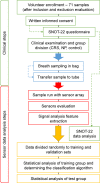Breath volatolomics for diagnosing chronic rhinosinusitis
- PMID: 30147315
- PMCID: PMC6097827
- DOI: 10.2147/IJN.S171488
Breath volatolomics for diagnosing chronic rhinosinusitis
Abstract
Purpose: Chronic rhinosinusitis (CRS) is one of the most common chronic diseases treated by primary care physicians. It is increasingly recognized that CRS and nasal polyposis (NP) comprise several disease processes with diverse causes. Hence, subgroups of sinusitis need to be differentiated so that patients can be screened appropriately and personalized medical treatment provided.
Patients and methods: To address this need, we use a cross-reactive nanoarray based on either molecularly modified gold nanoparticles or molecularly modified single-walled carbon nanotubes, combined with pattern recognition for analyzing breath samples. Breath samples were collected from three groups of volunteers (total 71) at the Hillel Yaffe Medical Center: CRS, NP, and control.
Results: Nanoarray results discriminated between patients with sinusitis and the control group with 87% sensitivity, 83% specificity, and 85% accuracy. The system also discriminated well between the subpopulations: 1) CRS vs control (76% sensitivity, 90% specificity); 2) CRS vs NP (82% sensitivity, 71% specificity); and 3) NP vs control (71% sensitivity, 90% specificity).
Conclusion: This preliminary study shows that a nanoarray-based breath test for screening population for sinusitis-related conditions is feasible.
Keywords: breath analysis; chronic sinusitis; nasal polyposis; sensor; volatile organic compound.
Conflict of interest statement
Disclosure The authors report no conflicts of interest in this work.
Figures



Similar articles
-
Diagnosis and Classification of 17 Diseases from 1404 Subjects via Pattern Analysis of Exhaled Molecules.ACS Nano. 2017 Jan 24;11(1):112-125. doi: 10.1021/acsnano.6b04930. Epub 2016 Dec 21. ACS Nano. 2017. PMID: 28000444 Free PMC article.
-
Role of exhaled nasal nitric oxide in distinguishing between chronic rhinosinusitis with and without nasal polyps.Am J Rhinol Allergy. 2017 Nov 19;31(6):389-394. doi: 10.2500/ajra.2017.31.4480. Epub 2017 Sep 19. Am J Rhinol Allergy. 2017. PMID: 28927489
-
A novel method for diagnosing chronic rhinosinusitis based on an electronic nose.An Otorrinolaringol Ibero Am. 2003;30(5):447-57. An Otorrinolaringol Ibero Am. 2003. PMID: 14648925
-
Diagnosis and management of chronic rhinosinusitis in adults.Postgrad Med. 2009 Nov;121(6):121-39. doi: 10.3810/pgm.2009.11.2081. Postgrad Med. 2009. PMID: 19940423 Review.
-
Rhinitis and sinusitis.J Allergy Clin Immunol. 2010 Feb;125(2 Suppl 2):S103-15. doi: 10.1016/j.jaci.2009.12.989. J Allergy Clin Immunol. 2010. PMID: 20176255 Review.
Cited by
-
Metabolomics, Microbiota, and In Vivo and In Vitro Biomarkers in Type 2 Severe Asthma: A Perspective Review.Metabolites. 2021 Sep 22;11(10):647. doi: 10.3390/metabo11100647. Metabolites. 2021. PMID: 34677362 Free PMC article. Review.
-
Chronic Rhinosinusitis-Microbiological Etiology, Potential Genetic Markers, and Diagnosis.Int J Mol Sci. 2024 Mar 11;25(6):3201. doi: 10.3390/ijms25063201. Int J Mol Sci. 2024. PMID: 38542175 Free PMC article. Review.
-
An Overview of the Application of Systems Biology in an Understanding of Chronic Rhinosinusitis (CRS) Development.J Pers Med. 2020 Nov 26;10(4):245. doi: 10.3390/jpm10040245. J Pers Med. 2020. PMID: 33255995 Free PMC article. Review.
-
Accuracy of the Electronic Nose Breath Tests in Clinical Application: A Systematic Review and Meta-Analysis.Biosensors (Basel). 2021 Nov 22;11(11):469. doi: 10.3390/bios11110469. Biosensors (Basel). 2021. PMID: 34821685 Free PMC article.
-
Sensors for detecting pulmonary diseases from exhaled breath.Eur Respir Rev. 2019 Jun 26;28(152):190011. doi: 10.1183/16000617.0011-2019. Print 2019 Jun 30. Eur Respir Rev. 2019. PMID: 31243097 Free PMC article. Review.
References
-
- Peng G, Tisch U, Adams O, et al. Diagnosing lung cancer in exhaled breath using gold nanoparticles. Nat Nanotechnol. 2009;4(10):669–673. - PubMed
-
- Zilberman Y, Ionescu R, Feng X, Mullen K, Haick H. Nanoarray of polycyclic aromatic hydrocarbons and carbon nanotubes for accurate and predictive detection in real-world environmental humidity. ACS Nano. 2011;5(8):6743–6753. - PubMed
-
- Wang B, Sonar P, Manzhos S, Haick H. Diketopyrrolopyrrole copolymers based chemical sensors for the detection and discrimination of volatile organic compounds. Sens Actuators B Chem. 2017;251:49–56.
-
- Dovgolevsky E, Tisch U, Haick H. Chemically sensitive resistors based on monolayer-capped cubic nanoparticles: towards configurable nanoporous sensors. Small. 2009;5(10):1158–1161. - PubMed
MeSH terms
Substances
LinkOut - more resources
Full Text Sources
Other Literature Sources
Medical
Miscellaneous

